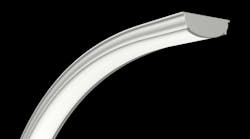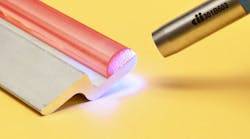Date Announced: 19 Jul 2009 -- Micro-coolers deliver highest electrical resistance, maximum efficiency, and lowest cost for thermal management of photonics and sensor applicationsFreiburg, Germany –- Micropelt GmbH, Freiburg, Germany-based manufacturer of thin film thermoelectrics, introduces the MPC-D40x series, a new generation of highly efficient thermoelectric coolers (TECs). Micropelt’s micro-structuring technology enables them to produce TECs with an electrical resistance of more than 30 Ohms on a single square millimeter footprint. The TEC, in combination with its controller system, can therefore be driven at an efficiency of 90% and better. This new approach will impact the system architecture of applications using small TECs including those where cooling is omitted for reasons of system cost and power dissipation. Applications include cooling of lower power laser diodes and other active or passive devices in the telecommunications, photonics, optoelectronics, and sensors markets.Micropelt’s MPC-D403/404 TECs are fabricated using semiconductor manufacturing processes that enable Micropelt to produce the world’s smallest micro-coolers. Feature sizes of 45 microns can accommodate 50 thermocouples per square millimeter, about ten times more than bulk Peltier technology can offer. “Our micro-structuring technology is able to scale to application specific dimensions, electrical requirements, and thermal properties,” explains Joachim Nurnus, CTO of Micropelt. “We measure drive currents 10 times smaller than those known for similar bulk TECs whose few thermocouples create an electrical resistance much below 1 Ohm and hence a drive current well above 1 ampere.”The MPC-D40x series can pump over 600 milliWatts with a drive current of 200 milliamps as required for thermal management of low power edge emitting lasers or VCSELs. At low drive currents the power efficiency of the TEC increases. At the same time, the design of the control circuitry can be simpler, which also translates to reductions on the bill-of-materials and circuit board footprint. “Everyone wants their transceiver modules to be smaller and more energy efficient,” says Wladimir Punt, VP sales and marketing for Micropelt. “We analyzed the thermoelectric system architecture and concluded that for very small TECs the drive current is key to solving the prevailing power consumption and heat dissipation issues. Cutting the drive current by 90% can improve the overall cooling system efficiency by 50%, because the drive voltage remains at a level where buck regulators can provide good efficiencies. This will help photonic packaging and system designers to develop components consuming less energy, producing less heat, and fitting into smaller packages.” Micropelt’s wafer-based production technology brings economies-of-scale to the high volume manufacture of TECs. The TEC control system not only benefits from standard, inexpensive, readily available, and ultra-small TEC control circuit components, but its overall power efficiency results in greatly reduced power consumption and heat dissipation on densely packed line cards. Micropelt’s micro-cooler represents a compelling technology for use with products not normally exposed to active cooling, but that would benefit from higher performance, tighter specifications, and further miniaturization. Samples of Micropelt’s MPC-D403 and MPC-D404 micro-coolers are now available. Volume pricing targets 3USD in quantities of 500,000 units. Detailed specifications are available on the MPC-D403/404 datasheet at http://www.micropelt.com/down/datasheet_mpc_d403_d404.pdf. A high resolution photo can be found at http://www.micropelt.com/images/im_press/d403_on_to46_with_ntc.jpgAbout MicropeltMicropelt GmbH, a 2006 spin-off from the research cooperation between Infineon Technologies and Fraunhofer Institute IPM Freiburg, develops and markets the world’s smallest and most effective thermoelectric elements for clean-tech power generation (energy harvesting) for sensing, cycling and cooling. Readily available standard products from the pilot-production plant at the company’s headquarters in Freiburg, Germany are currently being evaluated by and incorporated into the products of more than 40 customers. A large-scale production facility, fully financed and currently under construction in Halle, Sachsen-Anhalt, Germany, is expected to raise capacity to some 10 million devices per year by mid 2010. About Micropelt’s Thermoelectric Elements Micropelt’s thermoelectric elements are based on a proprietary scalable MEMS (Micro Electro-Mechanical Systems) micro-structuring platform technology. Compared to conventional thermoelectric elements, Micropelt’s unique and patented technology reduces component and feature sizes by orders of magnitude, yielding 10 times higher cooling or heating power densities. Economies of scale through volume production break the existing cost and price barriers of conventional thermoelectrics, enabling Micropelt’s devices to scavenge free electric power from waste heat to replace or recharge batteries in low power wireless sensor networks.
Contact
Wladimir Punt Micropelt GmbH Thermoelectric Cooling & Power Generation Emmy-Noether-Str. 2, 79110 Freiburg, Germany Tel: +49 761 156 337-55 Fax: +49 761 156 337–21
E-mail:[email protected]
Web Site:www.micropelt.com






